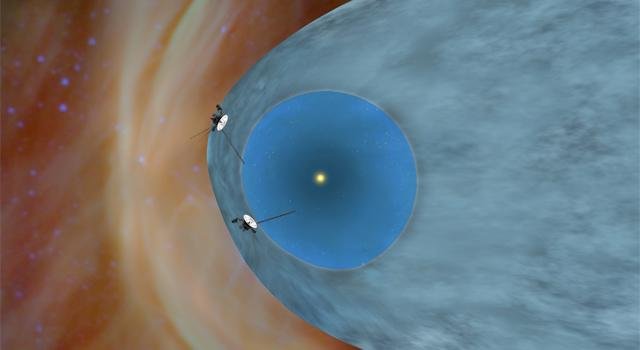This artist's concept shows NASA's two Voyager spacecraft exploring a turbulent region of space known as the heliosheath, the outer shell of the bubble of charged particles around our sun, called the heliosphere. (Credit: NASA/JPL-Caltech)
A new set of three papers on data from the interstellar probe Voyager 1 explain the last region of our solar system the craft is crossing before it reaches interstellar space.
The astronomical community was at odds earlier this year when the American Geophysical Union announced that Voyager 1 had indeed left the solar system. They quickly corrected the claim, and NASA acknowledged that the craft had entered a new region of space, but it was not interstellar.
The confusion began because Voyager 1 reached a point where charged particles from the sun run up against interstellar particles and effectively stop flowing out from our solar system. This range of solar particles is known as the heliosphere, and it's edge is the heliosheath.
The new papers, published in Science, focus on observations made from May to September 2012 by Voyager 1's cosmic ray, low-energy charged particle and magnetometer instruments, with additional charged particle data obtained through April of this year.
The craft is now in the helioshpere depletion region -- a zone characterized by an extreme drop in particles from the sun and an increase in cosmic rays, sometimes called the magnetic highway.
But although the particles flowing along the magnetic lines reaching out from the sun are disappearing, the magnetic lines themselves have not. The magnetic field Voyager is currently in is the field produced by the sun.
"A day made such a difference in this region with the magnetic field suddenly doubling and becoming extraordinarily smooth," said Leonard Burlaga, the lead author of one of the papers, and based at NASA's Goddard Space Flight Center. "But since there was no significant change in the magnetic field direction, we're still observing the field lines originating at the sun."
Results also show that the spacecraft crossed into and out of the heliosphere depletion region at least five times in 2012, suggesting bands of calm and turbulence as the region transitions into interstellar space.
Scientists do not know exactly when Voyager 1 will punch through the heliosheath, saying it could be tomorrow or it could take months or years. Once it does, it will be the first human made object to reach interstellar space.
Voyager 1 and its twin spacecraft, Voyager 2, were launched in 1977. They toured Jupiter, Saturn, Uranus and Neptune before embarking on their interstellar mission in 1990. They are now both on their way out of the heliosphere. Voyager 1 has so far traveled 11.5 billion miles.















